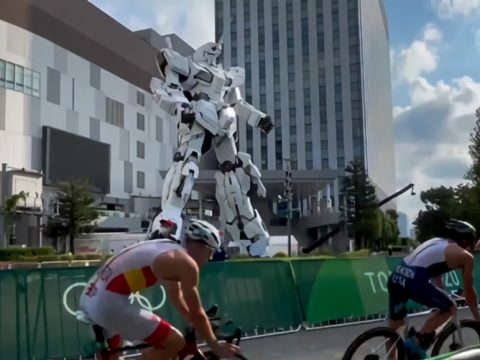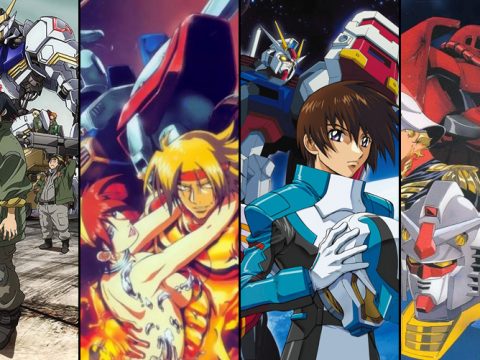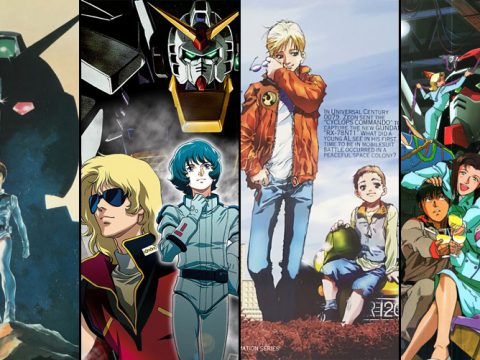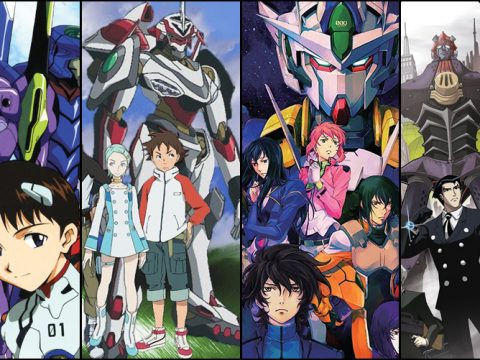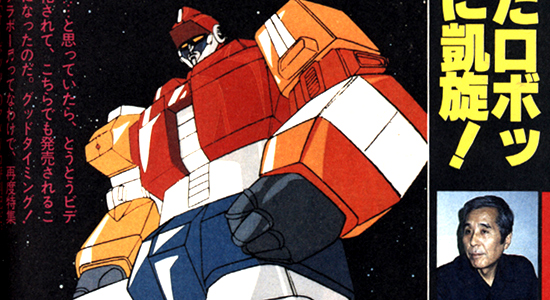
In tribute to the passing of anime director Osamu Dezaki, I decided to pull this piece out of mothballs. Hope you enjoy the trip down memory lane.
I was sitting around recently rummaging through my VHS collection when I came across an old favorite: my tape of Mighty Orbots episodes. I felt so much nostalgic excitement that I tried calling some of my friends over to watch it, but they didn’t remember it for some reason. They were able to recall other Saturday morning cartoons like The Littles and Dragon’s Lair, but not Orbots. I found that kind of sad, because this series was very much ahead of its time—even though it’s taken me a long time scrutinizing the show to figure out why. Let me explain.
Back in the ’70s and ’80s cartoons on Saturday mornings were handled on the three national networks: ABC, CBS, and NBC. Many of the series shown were produced by American studios such as Hanna-Barbera (The Smurfs, Space Ghost), Filmation (Blackstar, Tarzan) and Ruby-Spears (Superman, Thundarrr The Barbarian) among others. Most of these shows had very low budgets and tight schedules to work with as well as parental groups to please, which resulted in randomly-placed episodic stories, not to mention cartoons in which the artwork consisted of basic colors and simple designs for both the characters and the backgrounds they moved in, usually showing one or two movements at a time and maybe consisting of two layers for characters to interact with.
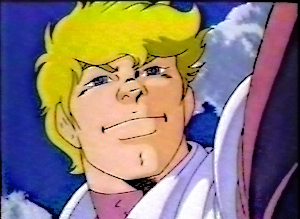 To offset rising inflation costs during the particularly brutal economy of that period, American writers and storyboard artists began farming out work to Japanese companies such as Toei Animation (Spider-Man and His Amazing Friends, Dungeons and Dragons). The early ’80s also saw a certain trend hit US shores, namely robotics. The Transformers and GoBots hit American shores in 1984 and quickly gained favor with the kids, in toy sales and viewing markets, as did Voltron: Defender of the Universe (and to a somewhat lesser degree, Tranzor-Z). Human interaction with shape-changing mecha was becoming the big fad, so Intermedia Entertainment and producer Fred Silverman took the idea of series creator Barry Glasser and collaborated with the Japanese animation studio TMS Entertainment (also known as Tokyo Movie Shinsha) and MGM/UA Entertainment to produce a new super robot based TV show, Mighty Orbots.
To offset rising inflation costs during the particularly brutal economy of that period, American writers and storyboard artists began farming out work to Japanese companies such as Toei Animation (Spider-Man and His Amazing Friends, Dungeons and Dragons). The early ’80s also saw a certain trend hit US shores, namely robotics. The Transformers and GoBots hit American shores in 1984 and quickly gained favor with the kids, in toy sales and viewing markets, as did Voltron: Defender of the Universe (and to a somewhat lesser degree, Tranzor-Z). Human interaction with shape-changing mecha was becoming the big fad, so Intermedia Entertainment and producer Fred Silverman took the idea of series creator Barry Glasser and collaborated with the Japanese animation studio TMS Entertainment (also known as Tokyo Movie Shinsha) and MGM/UA Entertainment to produce a new super robot based TV show, Mighty Orbots.
ABC began broadcasting Mighty Orbots in the fall of 1984. The cartoon’s mentality was pretty typical for Saturday morning fare. Taking place in the 23rd century, humanity and robots interact routinely with aliens since Earth is the headquarters of the Galactic Patrol, which governs several solar systems. They are being repeatedly attacked by an organization called Shadow under the command of Umbra, an evil super-cyborg hungry for galactic conquest. However, Umbra’s villainous efforts always fail whenever confronted by Earth’s greatest defender: the Mighty Orbots.
The Orbots were built by a bespectacled super genius named Rob Simmons. Along with a small assistant robot named Ohno (who screams “oh no!” before everything else she says), Rob leads the team of Tor (the strong, constantly-bragging orbot), Bort (the always-nervous multi-shape changer), Bo (the mischievous master of all elements), Boo (the innocent illusionist) and Crunch (the ever-hungry trash disposal orbot). Whenever trouble appears, Rob hits a button to wake up the team, changes from his street clothes to his Buck Rogers-styled “Omni Suit” and becomes The Orbots Commander, an identity in which nobody recognizes him since he’s not wearing his glasses (!). When the trouble gets really bad, Rob gives the command “Orbots, Unite!” and the Orbots combine to form a huge super robot, in a remarkable sequence which sees them somehow gain much more mass than they did separately. (Rob must’ve built them out of that Getter particle called “boolshiddium” or something…) This gestalt is large enough that Rob and Ohno can fly a small ship into its chest, and pilot the mecha anywhere for adventure.
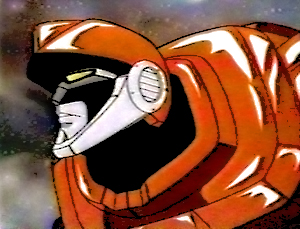
Like I said, the premise was pretty typical for ’80s American cartoons. However, a few elements made Mighty Orbots stand out above the other shows, the most obvious of which was the animation quality. I took my old tape full of episodes and showed it to several friends, (most of whom didn’t remember the show at all) and in between the “Holy S**ts,” “Oh my Gods,” and general agonizing shrieks of horror over the old commercials (especially the one about Ewok plushies), everyone was amazed by the incredibly fluid movements of multiple objects (15-16 on screen as opposed to maybe 2-3 in most cartoons) as well as the fact that very few frames had no movement in them. Even in scenes where a character is standing still and not talking, his face will still be rapidly twitching with some small object moving in the background, which had up to 8 layers of artwork sometimes for characters to interact with. That artwork ranged from super detailed mechanical designs comparable to ships in the expensive feature film Macross: Do You Remember Love, to landscapes that were as lush and vibrant as Hayao Miyazaki movies like Nausicaä and Laputa. For example, in the episode called “Leviathan”, the Orbots are called in to stop a gigantic whale-like creature and do so by traveling through a series of intricate interconnecting blood vessels while dodging heart valves and antibodies to reach a deactivation device.
The one scene I never got tired of watching, though, was the Orbots’ big transformation sequence. Actually, there were two versions of this. For the first few episodes the money shots were of the Orbots waking up from their chambers and flying off to meet Rob, with the actual stack-&-attack bit being relatively short (about 10 seconds). When the episode called “The Phoenix Factor” was broadcast, we got to see a new sequence lasting about 30 seconds in which super-detailed drawings of the Orbots combined while the “camera,” as it were, did a continuous dolly around the big robot. It was the usual trick of the animators saving money by having one transformation sequence repeat in each episode, but it was always an impressive sequence to watch nonetheless.
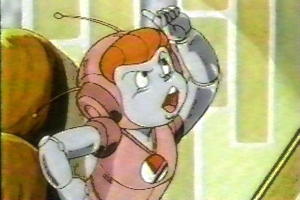
Right about now you’re probably thinking I’m exaggerating about the animation quality, but I can tell you this isn’t the case! Several times while watching this tape, my friends would ask me, “Was this REALLY done in 1984?” Then we’d see a commercial for Turbo Teen (AKA Pontiac’s answer to Ranma ½) or Super Friends or Wolfman Jack, and the shrieks of horror would resume because their animation quality was absolute crap in comparison. The excellent work in Orbots can be most directly attributed to auteur anime director Osamu Dezaki and his usual partner in crime Akio Sugino, who served as animation director for this project. Many of their techniques from anime such as Golgo 13 and Black Jack popped up frequently; high contrasts, motion lines, and shiny glares routinely reared their heads throughout the series. However, the duo’s notorious technique of doing a freeze frame on a painted piece for dramatic effect was never seen on Orbots. The general look was very slick and futuristic in a way, with Dezaki’s penchant for corner flares in many shots. Overall, I’d say this style most resembled their animation work on the Space Adventure Cobra movie. Veteran composer Yuji Ohno (best known for his work on the Lupin III series and films) provides a snappy ’80s-style synthesizer score, setting the stage for outer space adventures. (Thanks to Mike Toole for this musical tidbit.)
The animation accented the excellent voice work for which the animators articulated the English dialogue almost perfectly. My friends and I all mistook Rob’s voice for being Billy West, the man behind Fry on Futurama. Instead it turned out to be Barry Gordon, famous voice of Donatello the Teenage Mutant Ninja Turtle, as well as the Nestle’s Quik Rabbit. Gordon gave subtle distinction between geeky Rob and the confident Orbots Commander. He even turns in decent vocals for the show’s kickass opening sequence (possibly the best ever for a US cartoon.) Hanna-Barbera superstar Don Messick (AKA Dr. Benton Quest on Johnny Quest) commands the voice of Rondu, the Galactic Patrol’s mysterious elf-like leader with unknown powers, while former Bionic Woman mainstay and future voice of Ayeka on Tenchi Muyo! Jennifer Darling gave Rondu’s daughter Dia the flirtatious yet icily competent quality required for a top government agent. However, our real joy was in listening to narrator Gary Owens (voice of Blue Falcon, Roger Ramjet, and Space Ghost) give the show a funny and sometimes satiric intangible to keep reminding everyone viewing not to take the show seriously. For example, there’s an episode where the Orbots have to break through a very large door and Owens chimes in, “Not even Mighty Orbots can get through that! *SMASH* Oh. I guess I was wrong…”
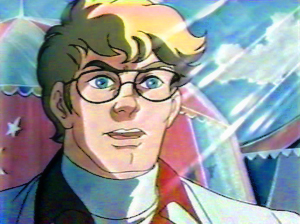 Another fascinating element about Orbots was the storyline style. Screen written by cartoon greats such as Michael Reaves and Donald Glut, the show was pretty wholesome and child oriented, but there was a bit of structure to the overall series and the last of the thirteen episodes that had been produced had something I’d never seen in a Saturday morning cartoon up until that point: a definitive ending. In the final episode, “Invasion of The Shadow Star,” Umbra devises a weapon to make Earth’s sun go nova. Meanwhile, the Orbots notice Rob has been working secretly on something. They hack into his computer and find designs for a new set of Orbots. Fearing they’re about to be replaced and scrapped, the group decides to bid a sad farewell and invade the Shadow Star (Umbra’s hollow home planet that has its own inner sun to warm it) to destroy the sun smasher WITHOUT Rob. The resulting wild adventure climaxes with the destruction of the Shadow Star and Umbra vowing vengeance somehow before he dissolves in the explosion.
Another fascinating element about Orbots was the storyline style. Screen written by cartoon greats such as Michael Reaves and Donald Glut, the show was pretty wholesome and child oriented, but there was a bit of structure to the overall series and the last of the thirteen episodes that had been produced had something I’d never seen in a Saturday morning cartoon up until that point: a definitive ending. In the final episode, “Invasion of The Shadow Star,” Umbra devises a weapon to make Earth’s sun go nova. Meanwhile, the Orbots notice Rob has been working secretly on something. They hack into his computer and find designs for a new set of Orbots. Fearing they’re about to be replaced and scrapped, the group decides to bid a sad farewell and invade the Shadow Star (Umbra’s hollow home planet that has its own inner sun to warm it) to destroy the sun smasher WITHOUT Rob. The resulting wild adventure climaxes with the destruction of the Shadow Star and Umbra vowing vengeance somehow before he dissolves in the explosion.
So after seeing all these superlatives being written, you’re probably wondering, “If this show was so good, why wasn’t it more successful with more episodes and greater presence among kids of that time?” Well, there were a couple major factors contributing to its demise. First and foremost was toy sales, or the lack thereof in Orbots‘ case. There weren’t any created for the series, so no revenue could go back to the sponsors like they could for more successful cartoons. Since there weren’t any toys for the kids to play with, this resulted in lower ratings, which ABC looked at closely since Orbots was a decidedly more expensive show. There are also some allusions to a lawsuit Tonka filed against TMS Entertainment claiming Orbots infringed on their Go-Bots line, which was somewhat ironic since Orbots was a weekend show that had no toy line, while Go-Bots was nothing but a cheaply animated Hanna-Barbera weekday series with mecha designs swiped from Genesis Climber Mospeada, Machine Robo, and other mecha anime. In any case the result was Orbots showing on TV for only one year before it disappeared off the radar and into TV history.
Mighty Orbots did have limited life after its initial run with a broadcast in Japan in 1988, as well as sales of VHS tapes from MGM Home Video, with a stingy one episode per tape. Strangely, though, the video quality on these tapes was darker, not totally as sharp as the broadcast quality. I guess tape duplication wasn’t that big of a deal then. Nonetheless, Orbots never regained any of the limited popularity it had during the fall of 1984, and as far as I’m concerned that’s a real shame.
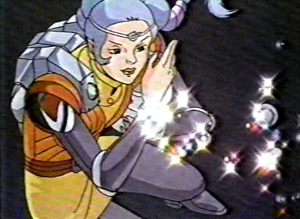 More than twenty years have passed since this show was introduced, and I haven’t seen a stack-&-attack super robot show with as much effort put into its production as Orbots… well, at least until King of Braves Gaogaigar premiered in Japan. Sure, the stories were for kids, but there was some incredible work done here which stacks up favorably to many current anime being produced. Mighty Orbots was truly ahead of its time and deserves as much notoriety as Voltron and Transformers have retained through the years. If anyone from Media Blasters, Discotek or any other nostalgic DVD label reads this, I hope they’ll consider creating a Mighty Orbots DVD collection alongside the other ’80s cartoon collections such as Galaxy High School, Starcom, and Adventures of the Galaxy Rangers, which have been released.
More than twenty years have passed since this show was introduced, and I haven’t seen a stack-&-attack super robot show with as much effort put into its production as Orbots… well, at least until King of Braves Gaogaigar premiered in Japan. Sure, the stories were for kids, but there was some incredible work done here which stacks up favorably to many current anime being produced. Mighty Orbots was truly ahead of its time and deserves as much notoriety as Voltron and Transformers have retained through the years. If anyone from Media Blasters, Discotek or any other nostalgic DVD label reads this, I hope they’ll consider creating a Mighty Orbots DVD collection alongside the other ’80s cartoon collections such as Galaxy High School, Starcom, and Adventures of the Galaxy Rangers, which have been released.
For now, though, I’ll just pop in my old VHS tape whenever I need a fix.


![SSSS.Dynazenon [Anime Review] SSSS.Dynazenon [Anime Review]](https://otakuusamagazine.com/wp-content/uploads/2021/08/16-9-SSSS.Dynazenon_Key_Visual_3.5-480x360.jpg)
![Back Arrow [Anime Review] Back Arrow [Anime Review]](https://otakuusamagazine.com/wp-content/uploads/2021/07/ba15-02686-480x360.jpg)
